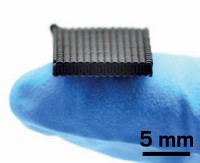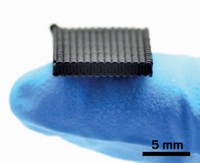Advertisement
Grab your lab coat. Let's get started
Welcome!
Welcome!
Create an account below to get 6 C&EN articles per month, receive newsletters and more - all free.
It seems this is your first time logging in online. Please enter the following information to continue.
As an ACS member you automatically get access to this site. All we need is few more details to create your reading experience.
Not you? Sign in with a different account.
Not you? Sign in with a different account.
ERROR 1
ERROR 1
ERROR 2
ERROR 2
ERROR 2
ERROR 2
ERROR 2
Password and Confirm password must match.
If you have an ACS member number, please enter it here so we can link this account to your membership. (optional)
ERROR 2
ACS values your privacy. By submitting your information, you are gaining access to C&EN and subscribing to our weekly newsletter. We use the information you provide to make your reading experience better, and we will never sell your data to third party members.
Electronic Materials
Spray-coated electrodes could create greener, cheaper batteries
By ditching toxic solvents, new dry-coating process could slash the cost and energy use of battery-manufacturing
by Prachi Patel, special to C&EN
May 25, 2023
| A version of this story appeared in
Volume 101, Issue 17
A new solvent-free manufacturing process could make batteries more sustainable and cut manufacturing costs by 15% and energy use by 47% (Joule 2023, DOI: 10.1016/j.joule.2023.04.006). It could also be faster-charging than today’s electrodes.
Manufacturers make electrodes by coating metal foils with a slurry of a solvent and battery materials. Then they recover the solvent and dry the electrodes. The energy-intensive process uses ovens the length of a football field.
Alternatively, Yan Wang of Worcester Polytechnic Institute, Heng Pan of Texas A&M University, and their colleagues spray a dry, powdery mix of electrode materials onto metal foils. An electric field at the sprayer’s tip applies a charge to the powder so it forms a uniform coating on the grounded metal substrate. The researchers then use pressure rollers to compact the material and form a dense electrode.
Other researchers have developed a dry-coating process that involves extruding electrode materials into freestanding, laminated films, Wang says. But the new spray process “is much more scalable and more similar to the wet-slurry technology used today.”
The team used commercial electrode materials: lithium-metal oxides for cathode, and graphite for anode. Because the new process should produce thicker electrodes, Wang says electric vehicle batteries could pack more energy and extend the driving range.
Ajay K. Prasad, a mechanical engineer at the University of Delaware, says that this electrostatic spraying process might be too slow for high-speed battery manufacturing, but given the energy and environmental benefits of solvent-free electrodes, new methods such as this one “are worthwhile to explore.”





Join the conversation
Contact the reporter
Submit a Letter to the Editor for publication
Engage with us on Twitter